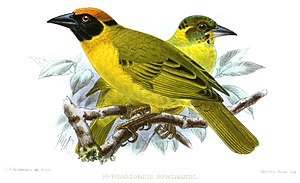Bertrand-Weber
| Bertrand-Weber | ||||||||||||
|---|---|---|---|---|---|---|---|---|---|---|---|---|

Bertrand-Weber ( Ploceus bertrandi ), illustration by Keulemans - Ibis 1893, male and young bird |
||||||||||||
| Systematics | ||||||||||||
|
||||||||||||
| Scientific name | ||||||||||||
| Ploceus bertrandi | ||||||||||||
| ( Shelley , 1893) |

The Bertrand-Weber or Malawi Weber ( ploceus Bertrandi , syn. Hyphantornis Bertrandi; Hyphantornis nyasae; ploceus fülleborni; ploceus nyasae ) has within the family of the weaver birds (Ploceidae) for genus of bunting (Ploceus).
The Latin additional species refers to Bertram Lutley Sclater, the son of ornithologist Philip Lutley Sclater .
The bird is found in Africa in Malawi , Mozambique , Zambia and Tanzania .
The distribution area includes open tree-lined habitats , thickets on rivers, miombo , forest edges from 900 to 1800 m height.
features
The species is 15 cm tall and weighs between 35 and 43 g. The male is golden yellow on the forehead to the crown with a strong orange yellow in front and a black band in the back. The black face mask extends to the throat. The iris is pale yellow. Upper side, rump and tail are green, wing-coverts darker with green edges. The female has an almost completely black head. Young birds look like females, but the head is speckled blackish-green.
The species is monotypical .
voice
The male's singing is described as initially squeaking, followed by clicks, but also canary- like squiggles and cat-like sounds. The contact call is a repeated “wink wink”.
Way of life
The diet consists mainly of insects , which are picked up from the leaves in pairs or in small groups, and nectar .
The breeding season is in April in Tanzania, between November and December in Zambia and between August and April in Malawi. The species is monogamous and breeds individually. The clutch consists of 2 dark green, strongly red-brown spotted eggs. The young birds are cared for by both parent birds.
Hazardous situation
The stock is not considered to be at risk ( least concern ).
literature
- GE Shelley: On Birds collected in Nyassaland. In: The Ibis Vol V, 1893, Sixth Series No. 17-20, p. 23
- RJ Dowsett & JA Jobling: Bertram Lutley Sclater and Bertram's Weaver Ploceus Bertrandi. in: Bulletin of the British Ornithologists' Club . Vol 123, 2003, p. 136
Web links
- Videos, photos and sound recordings of Ploceus bertrandi in the Internet Bird Collection
- Weaver Watch
Individual evidence
- ^ Bertrand-Weber , in Avibase - The world bird database
- ^ JA Jobling: A Dictionary of Scientific Bird Names. Oxford University Press. 1991. ISBN 0-19-854634-3 .
- ^ B. Beolens, M. Watkins: Whose Bird ?: Common Bird Names and the People They Commemorate , Christopher Helm, London, 2003
- ↑ a b c d Handbook of the Birds of the World
- ^ A b c T. Stevenson, J. Fanshawe: Birds of East Africa. Kenya, Tanzania, Uganda, Rwanda, and Burundi. Princeton University Press, 2002, ISBN 978-0-691-12665-4 .
- ↑ Old World sparrows, snowfinches, weavers
- ↑ Redlist